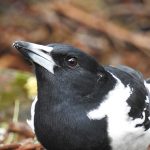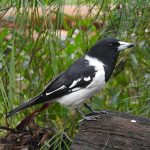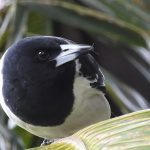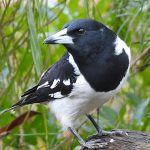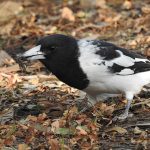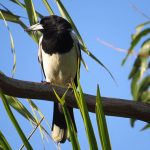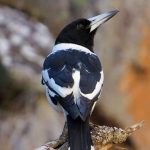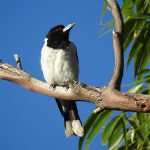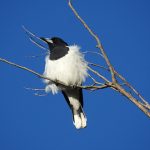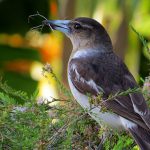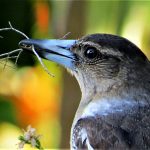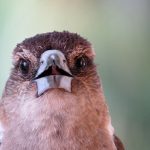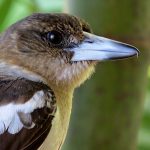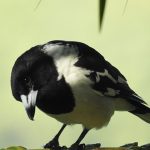PIED BUTCHERBIRD
Sharon: Quite a story to this little Fella. Our Resident Pied Butcherbirds came to visit us one day during a severe storm. They brought with them their young fledgling and positioned him on our verandah handrail, out of the storm. It was right next to where we have our breakfast, so we were very close to this little one. He was not frightened of us and so we named him ‘Cyclone’. Days past and the parent birds decided we were perfect as babysitters, and they brought little Cyclone in each day while they went of hunting for food. Cyclone grew up and over time he started singing to us. He was an adorable wild bird that befriended us and entertained us with his lovely Songs. Have a listen
The Pied Butcherbird: A Songbird of the Australian Landscape
Striking Appearance
The Pied Butcherbird is a medium-sized bird, similar in stature to its close relative, the Grey Butcherbird. Its striking black and white plumage makes it easily recognisable:
- The upperparts, wings, and tail are a deep glossy black, contrasting sharply with its snow-white underparts.
- A bold black band stretches across its throat and upper breast, creating the distinctive “pied” effect that gives the species its name.
- The strong, hooked bill is perfectly adapted for its carnivorous lifestyle.
Range and Habitat
Pied Butcherbirds are native to Australia and thrive across most of the mainland:
- Their range extends from the humid tropics of northern Queensland and the Northern Territory, down to the more temperate southern states.
- They prefer open woodlands, savannas, and lightly timbered forests, but are also frequently seen near farmland, urban parks, and gardens.
- While they avoid dense rainforests, their adaptability allows them to flourish in a variety of habitats.
Diet and Hunting Behaviour
As skilled predators, Pied Butcherbirds have a varied and robust diet:
- They feed on insects, small mammals, reptiles, and birds, demonstrating remarkable agility and precision.
- Their powerful, hooked bill is used to seize prey, which may be dispatched quickly or stored for later.
- Uniquely, these birds sometimes impale larger prey on sharp twigs, thorns, or even barbed wire—creating a natural larder.
The Melodious Voice
One of the Pied Butcherbird’s most remarkable features is its exquisite song:
- Their vocalisations are a symphony of clear, flutelike notes, melodious trills, and complex musical phrases.
- Each bird’s song is unique, and their dawn and dusk performances have inspired comparisons to human composers.
- They are also adept mimics, sometimes echoing the calls of other birds, the sounds of frogs, or even mechanical noises from their surroundings.
Life Cycle and Family
Pied Butcherbirds are monogamous, forming strong, enduring pair bonds:
- They construct cup-shaped nests from twigs and plant fibres, typically in the fork of a tree branch, well above the ground.
- The female usually lays 2–3 pale eggs, speckled with brown.
- Both parents share incubation duties and are attentive carers, feeding and protecting the chicks until they are ready to fledge.
- Family groups may remain together after the breeding season, with older siblings sometimes helping to feed and defend new broods.
Relatives and Classification
The Pied Butcherbird belongs to the butcherbird family (Cracticidae), sharing the genus Cracticus with:
- The Grey Butcherbird (Cracticus torquatus): Known for its softer grey and white plumage and equally enchanting song.
- The Black Butcherbird (Cracticus quoyi): Found predominantly in northern Australia, with a more uniform dark appearance.
All butcherbirds are renowned for their intelligence, resourceful hunting methods, and distinctive black-and-white markings.
A Symphony of the Bush
Encountering a Pied Butcherbird is a multi-sensory delight:
- Sight: Watch as it perches with poise, surveying its surroundings with keen, intelligent eyes.
- Sound: Listen for its rich, flute-like calls that echo through the dawn air, weaving an aural tapestry unique to the Australian bush.
- Movement: Observe their swift, agile flights as they patrol their territory or swoop gracefully to the ground in pursuit of prey.
Conservation and Connection
While the Pied Butcherbird is currently common and widespread, their presence reminds us of the vital role predatory birds play in maintaining healthy ecosystems. Protecting their habitats ensures that their beautiful songs continue to enrich Australia’s natural soundscape for generations to come.
The Pied Butcherbird is more than just a striking bird—it is a living melody, a symbol of Australia’s unique and vibrant wildlife, and a powerful reminder of the importance of conserving our natural heritage.

